Curriculum: Theory, Practice, Change, Differentiation, and Ideology
VerifiedAdded on 2022/08/25
|12
|3784
|13
Essay
AI Summary
This essay provides a comprehensive overview of curriculum theory and practice, emphasizing the importance of change and differentiation in education. It explores various aspects of curriculum, including its definition as content, product, and process, and examines the issues associated with each perspective. The essay delves into the influence of ideologies, such as progressivism and cognitive pluralism, on curriculum design and implementation. It further discusses the role of curriculum in selecting learning experiences, providing structure, and aligning content with student needs. The essay highlights the impact of scientific management on curriculum theory and the significance of curriculum change for both teachers and schools. It also addresses curriculum differentiation, universal curriculum, and the need for teachers to adapt to a changing society. The essay references UN goals for sustainable development and teacher education, emphasizing student-centered pedagogical strategies. Overall, the essay provides a valuable understanding of curriculum theory and its practical implications in the field of education.
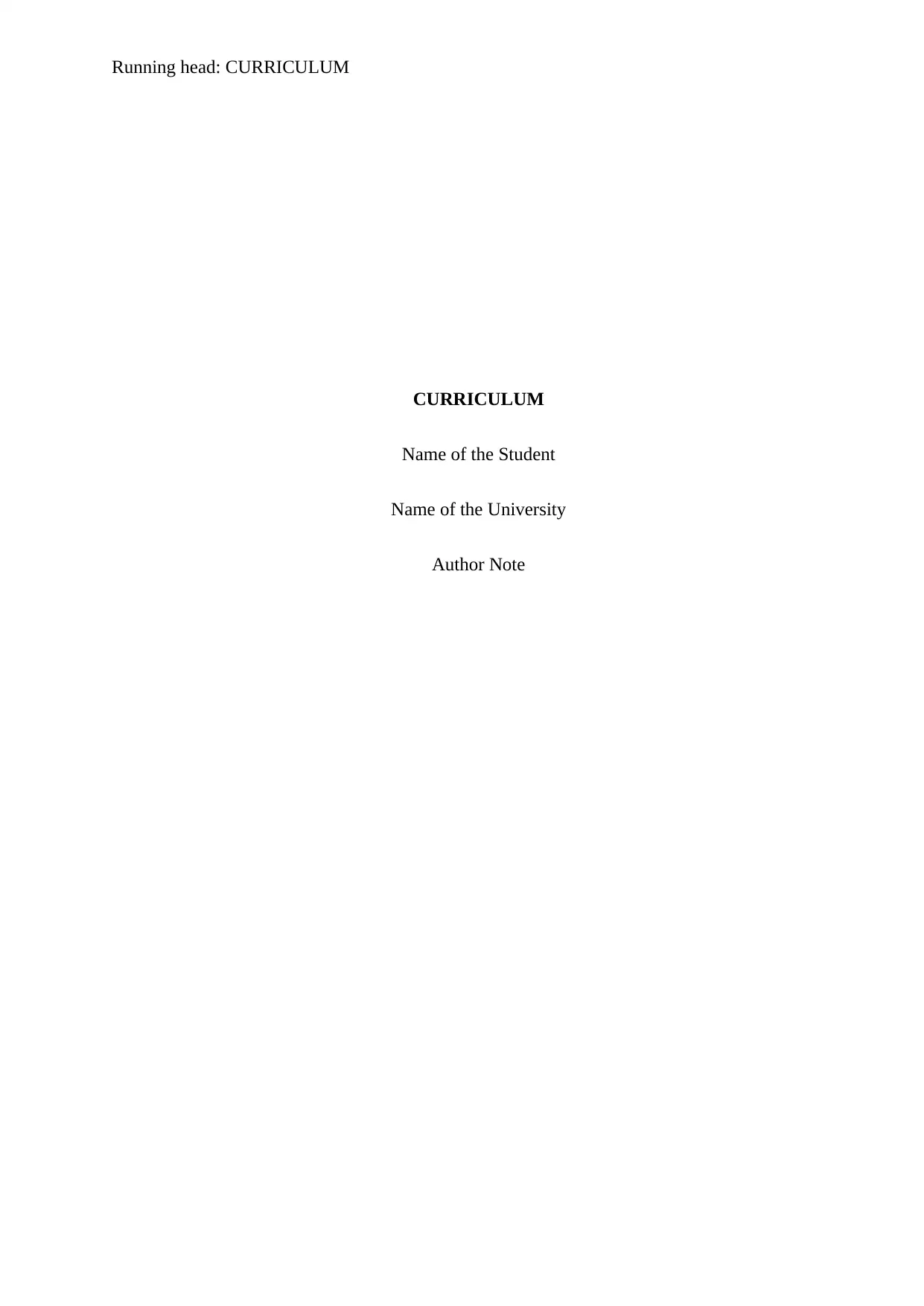
Running head: CURRICULUM
CURRICULUM
Name of the Student
Name of the University
Author Note
CURRICULUM
Name of the Student
Name of the University
Author Note
Paraphrase This Document
Need a fresh take? Get an instant paraphrase of this document with our AI Paraphraser
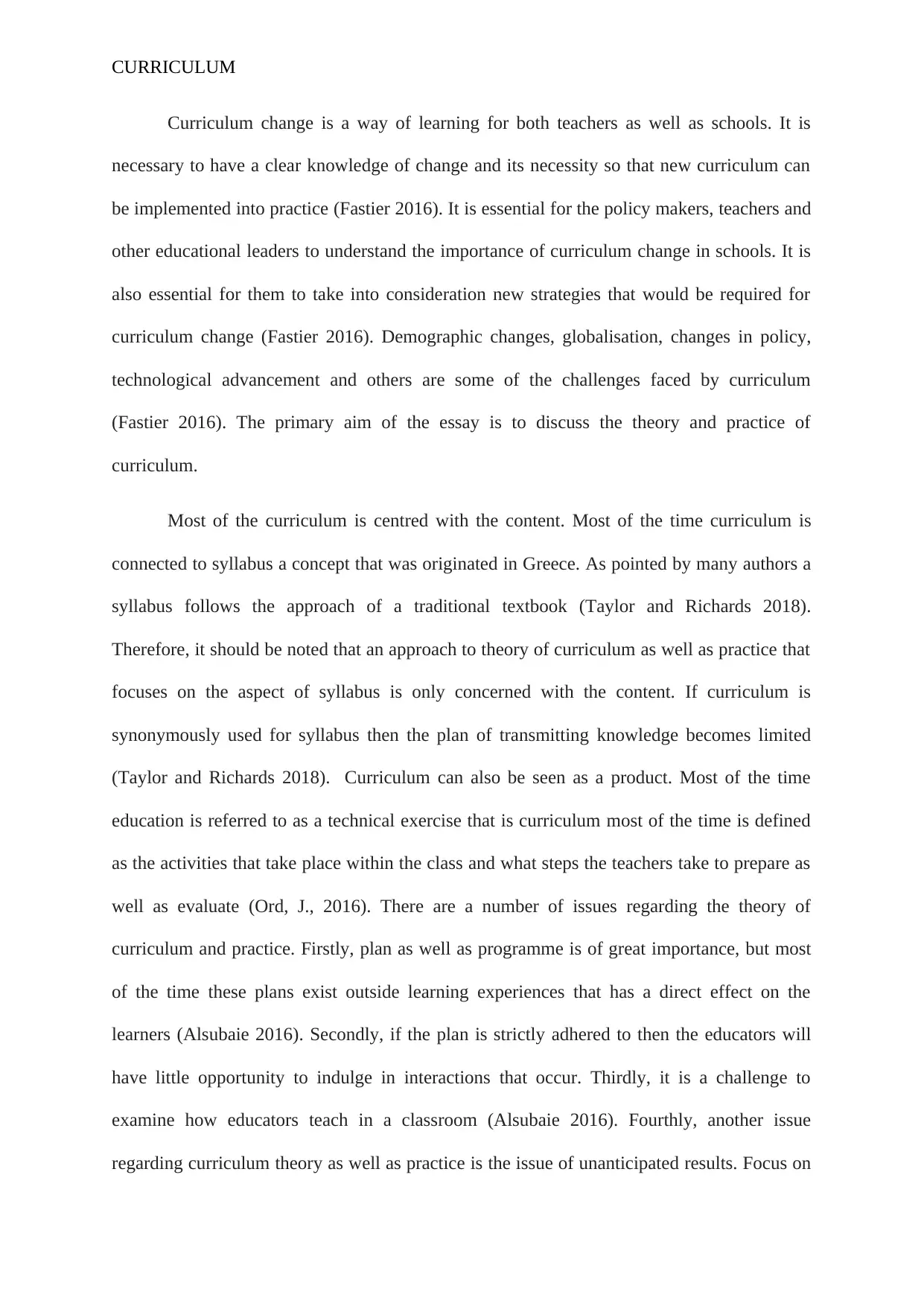
CURRICULUM
Curriculum change is a way of learning for both teachers as well as schools. It is
necessary to have a clear knowledge of change and its necessity so that new curriculum can
be implemented into practice (Fastier 2016). It is essential for the policy makers, teachers and
other educational leaders to understand the importance of curriculum change in schools. It is
also essential for them to take into consideration new strategies that would be required for
curriculum change (Fastier 2016). Demographic changes, globalisation, changes in policy,
technological advancement and others are some of the challenges faced by curriculum
(Fastier 2016). The primary aim of the essay is to discuss the theory and practice of
curriculum.
Most of the curriculum is centred with the content. Most of the time curriculum is
connected to syllabus a concept that was originated in Greece. As pointed by many authors a
syllabus follows the approach of a traditional textbook (Taylor and Richards 2018).
Therefore, it should be noted that an approach to theory of curriculum as well as practice that
focuses on the aspect of syllabus is only concerned with the content. If curriculum is
synonymously used for syllabus then the plan of transmitting knowledge becomes limited
(Taylor and Richards 2018). Curriculum can also be seen as a product. Most of the time
education is referred to as a technical exercise that is curriculum most of the time is defined
as the activities that take place within the class and what steps the teachers take to prepare as
well as evaluate (Ord, J., 2016). There are a number of issues regarding the theory of
curriculum and practice. Firstly, plan as well as programme is of great importance, but most
of the time these plans exist outside learning experiences that has a direct effect on the
learners (Alsubaie 2016). Secondly, if the plan is strictly adhered to then the educators will
have little opportunity to indulge in interactions that occur. Thirdly, it is a challenge to
examine how educators teach in a classroom (Alsubaie 2016). Fourthly, another issue
regarding curriculum theory as well as practice is the issue of unanticipated results. Focus on
Curriculum change is a way of learning for both teachers as well as schools. It is
necessary to have a clear knowledge of change and its necessity so that new curriculum can
be implemented into practice (Fastier 2016). It is essential for the policy makers, teachers and
other educational leaders to understand the importance of curriculum change in schools. It is
also essential for them to take into consideration new strategies that would be required for
curriculum change (Fastier 2016). Demographic changes, globalisation, changes in policy,
technological advancement and others are some of the challenges faced by curriculum
(Fastier 2016). The primary aim of the essay is to discuss the theory and practice of
curriculum.
Most of the curriculum is centred with the content. Most of the time curriculum is
connected to syllabus a concept that was originated in Greece. As pointed by many authors a
syllabus follows the approach of a traditional textbook (Taylor and Richards 2018).
Therefore, it should be noted that an approach to theory of curriculum as well as practice that
focuses on the aspect of syllabus is only concerned with the content. If curriculum is
synonymously used for syllabus then the plan of transmitting knowledge becomes limited
(Taylor and Richards 2018). Curriculum can also be seen as a product. Most of the time
education is referred to as a technical exercise that is curriculum most of the time is defined
as the activities that take place within the class and what steps the teachers take to prepare as
well as evaluate (Ord, J., 2016). There are a number of issues regarding the theory of
curriculum and practice. Firstly, plan as well as programme is of great importance, but most
of the time these plans exist outside learning experiences that has a direct effect on the
learners (Alsubaie 2016). Secondly, if the plan is strictly adhered to then the educators will
have little opportunity to indulge in interactions that occur. Thirdly, it is a challenge to
examine how educators teach in a classroom (Alsubaie 2016). Fourthly, another issue
regarding curriculum theory as well as practice is the issue of unanticipated results. Focus on
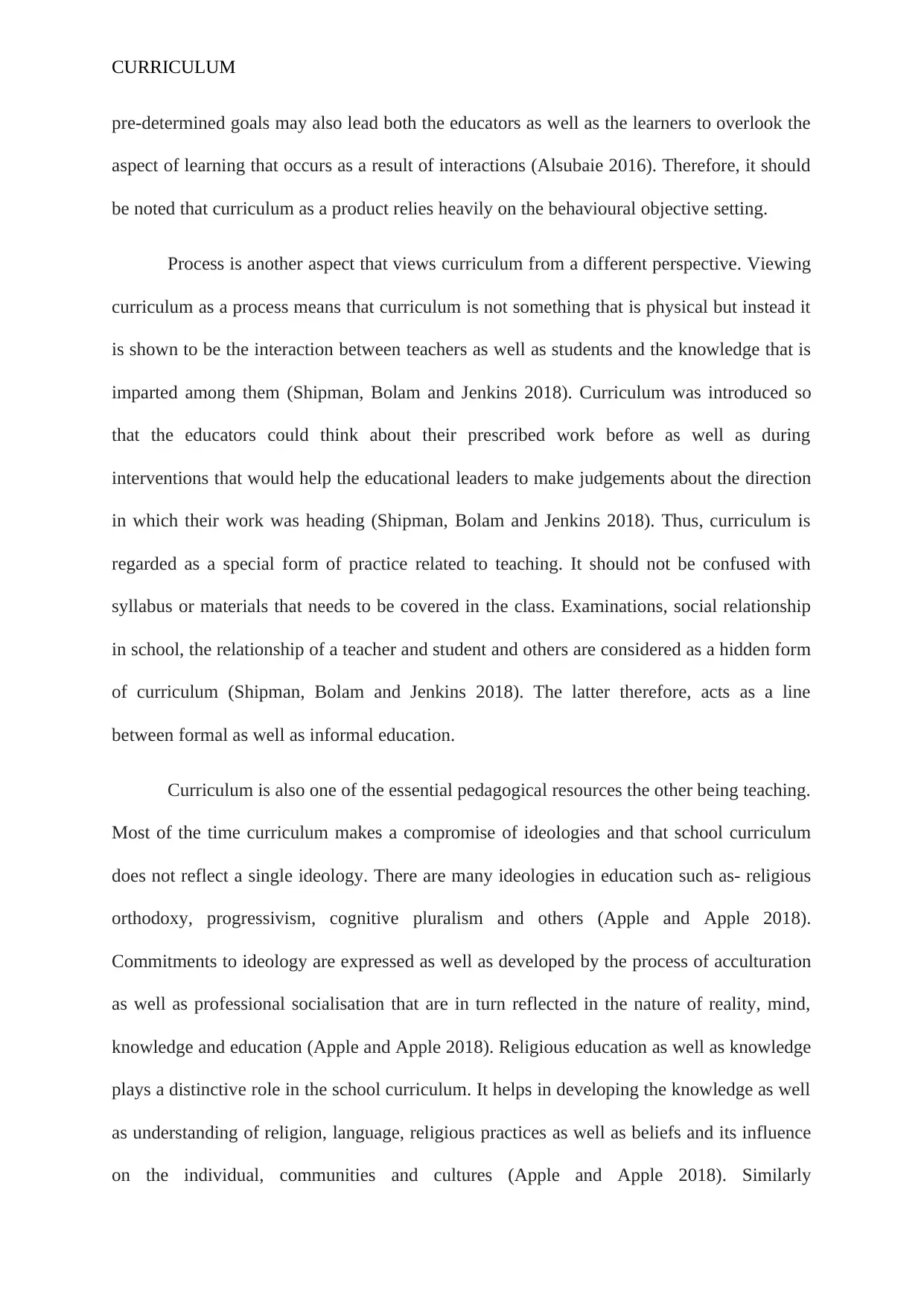
CURRICULUM
pre-determined goals may also lead both the educators as well as the learners to overlook the
aspect of learning that occurs as a result of interactions (Alsubaie 2016). Therefore, it should
be noted that curriculum as a product relies heavily on the behavioural objective setting.
Process is another aspect that views curriculum from a different perspective. Viewing
curriculum as a process means that curriculum is not something that is physical but instead it
is shown to be the interaction between teachers as well as students and the knowledge that is
imparted among them (Shipman, Bolam and Jenkins 2018). Curriculum was introduced so
that the educators could think about their prescribed work before as well as during
interventions that would help the educational leaders to make judgements about the direction
in which their work was heading (Shipman, Bolam and Jenkins 2018). Thus, curriculum is
regarded as a special form of practice related to teaching. It should not be confused with
syllabus or materials that needs to be covered in the class. Examinations, social relationship
in school, the relationship of a teacher and student and others are considered as a hidden form
of curriculum (Shipman, Bolam and Jenkins 2018). The latter therefore, acts as a line
between formal as well as informal education.
Curriculum is also one of the essential pedagogical resources the other being teaching.
Most of the time curriculum makes a compromise of ideologies and that school curriculum
does not reflect a single ideology. There are many ideologies in education such as- religious
orthodoxy, progressivism, cognitive pluralism and others (Apple and Apple 2018).
Commitments to ideology are expressed as well as developed by the process of acculturation
as well as professional socialisation that are in turn reflected in the nature of reality, mind,
knowledge and education (Apple and Apple 2018). Religious education as well as knowledge
plays a distinctive role in the school curriculum. It helps in developing the knowledge as well
as understanding of religion, language, religious practices as well as beliefs and its influence
on the individual, communities and cultures (Apple and Apple 2018). Similarly
pre-determined goals may also lead both the educators as well as the learners to overlook the
aspect of learning that occurs as a result of interactions (Alsubaie 2016). Therefore, it should
be noted that curriculum as a product relies heavily on the behavioural objective setting.
Process is another aspect that views curriculum from a different perspective. Viewing
curriculum as a process means that curriculum is not something that is physical but instead it
is shown to be the interaction between teachers as well as students and the knowledge that is
imparted among them (Shipman, Bolam and Jenkins 2018). Curriculum was introduced so
that the educators could think about their prescribed work before as well as during
interventions that would help the educational leaders to make judgements about the direction
in which their work was heading (Shipman, Bolam and Jenkins 2018). Thus, curriculum is
regarded as a special form of practice related to teaching. It should not be confused with
syllabus or materials that needs to be covered in the class. Examinations, social relationship
in school, the relationship of a teacher and student and others are considered as a hidden form
of curriculum (Shipman, Bolam and Jenkins 2018). The latter therefore, acts as a line
between formal as well as informal education.
Curriculum is also one of the essential pedagogical resources the other being teaching.
Most of the time curriculum makes a compromise of ideologies and that school curriculum
does not reflect a single ideology. There are many ideologies in education such as- religious
orthodoxy, progressivism, cognitive pluralism and others (Apple and Apple 2018).
Commitments to ideology are expressed as well as developed by the process of acculturation
as well as professional socialisation that are in turn reflected in the nature of reality, mind,
knowledge and education (Apple and Apple 2018). Religious education as well as knowledge
plays a distinctive role in the school curriculum. It helps in developing the knowledge as well
as understanding of religion, language, religious practices as well as beliefs and its influence
on the individual, communities and cultures (Apple and Apple 2018). Similarly
⊘ This is a preview!⊘
Do you want full access?
Subscribe today to unlock all pages.

Trusted by 1+ million students worldwide
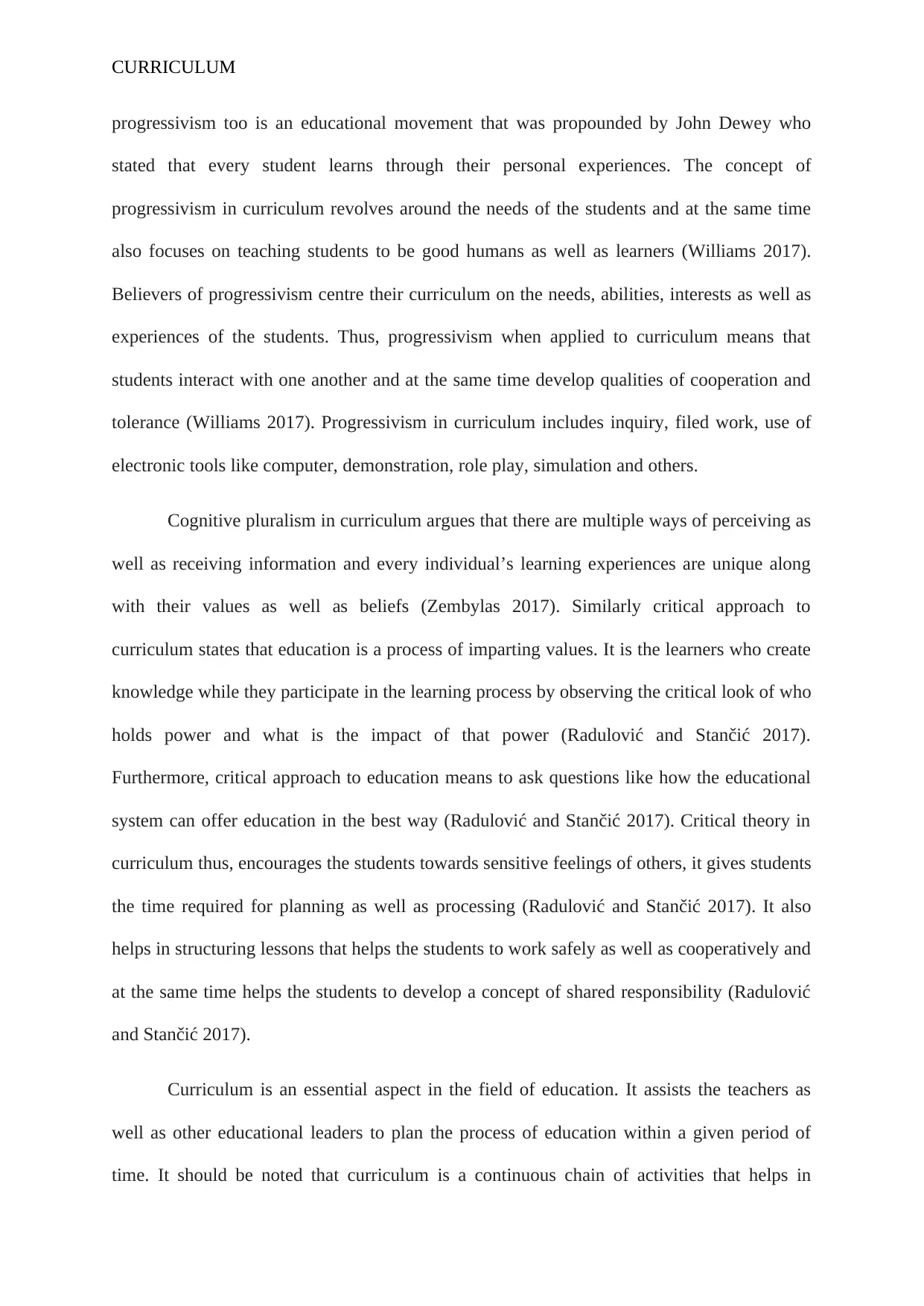
CURRICULUM
progressivism too is an educational movement that was propounded by John Dewey who
stated that every student learns through their personal experiences. The concept of
progressivism in curriculum revolves around the needs of the students and at the same time
also focuses on teaching students to be good humans as well as learners (Williams 2017).
Believers of progressivism centre their curriculum on the needs, abilities, interests as well as
experiences of the students. Thus, progressivism when applied to curriculum means that
students interact with one another and at the same time develop qualities of cooperation and
tolerance (Williams 2017). Progressivism in curriculum includes inquiry, filed work, use of
electronic tools like computer, demonstration, role play, simulation and others.
Cognitive pluralism in curriculum argues that there are multiple ways of perceiving as
well as receiving information and every individual’s learning experiences are unique along
with their values as well as beliefs (Zembylas 2017). Similarly critical approach to
curriculum states that education is a process of imparting values. It is the learners who create
knowledge while they participate in the learning process by observing the critical look of who
holds power and what is the impact of that power (Radulović and Stančić 2017).
Furthermore, critical approach to education means to ask questions like how the educational
system can offer education in the best way (Radulović and Stančić 2017). Critical theory in
curriculum thus, encourages the students towards sensitive feelings of others, it gives students
the time required for planning as well as processing (Radulović and Stančić 2017). It also
helps in structuring lessons that helps the students to work safely as well as cooperatively and
at the same time helps the students to develop a concept of shared responsibility (Radulović
and Stančić 2017).
Curriculum is an essential aspect in the field of education. It assists the teachers as
well as other educational leaders to plan the process of education within a given period of
time. It should be noted that curriculum is a continuous chain of activities that helps in
progressivism too is an educational movement that was propounded by John Dewey who
stated that every student learns through their personal experiences. The concept of
progressivism in curriculum revolves around the needs of the students and at the same time
also focuses on teaching students to be good humans as well as learners (Williams 2017).
Believers of progressivism centre their curriculum on the needs, abilities, interests as well as
experiences of the students. Thus, progressivism when applied to curriculum means that
students interact with one another and at the same time develop qualities of cooperation and
tolerance (Williams 2017). Progressivism in curriculum includes inquiry, filed work, use of
electronic tools like computer, demonstration, role play, simulation and others.
Cognitive pluralism in curriculum argues that there are multiple ways of perceiving as
well as receiving information and every individual’s learning experiences are unique along
with their values as well as beliefs (Zembylas 2017). Similarly critical approach to
curriculum states that education is a process of imparting values. It is the learners who create
knowledge while they participate in the learning process by observing the critical look of who
holds power and what is the impact of that power (Radulović and Stančić 2017).
Furthermore, critical approach to education means to ask questions like how the educational
system can offer education in the best way (Radulović and Stančić 2017). Critical theory in
curriculum thus, encourages the students towards sensitive feelings of others, it gives students
the time required for planning as well as processing (Radulović and Stančić 2017). It also
helps in structuring lessons that helps the students to work safely as well as cooperatively and
at the same time helps the students to develop a concept of shared responsibility (Radulović
and Stančić 2017).
Curriculum is an essential aspect in the field of education. It assists the teachers as
well as other educational leaders to plan the process of education within a given period of
time. It should be noted that curriculum is a continuous chain of activities that helps in
Paraphrase This Document
Need a fresh take? Get an instant paraphrase of this document with our AI Paraphraser
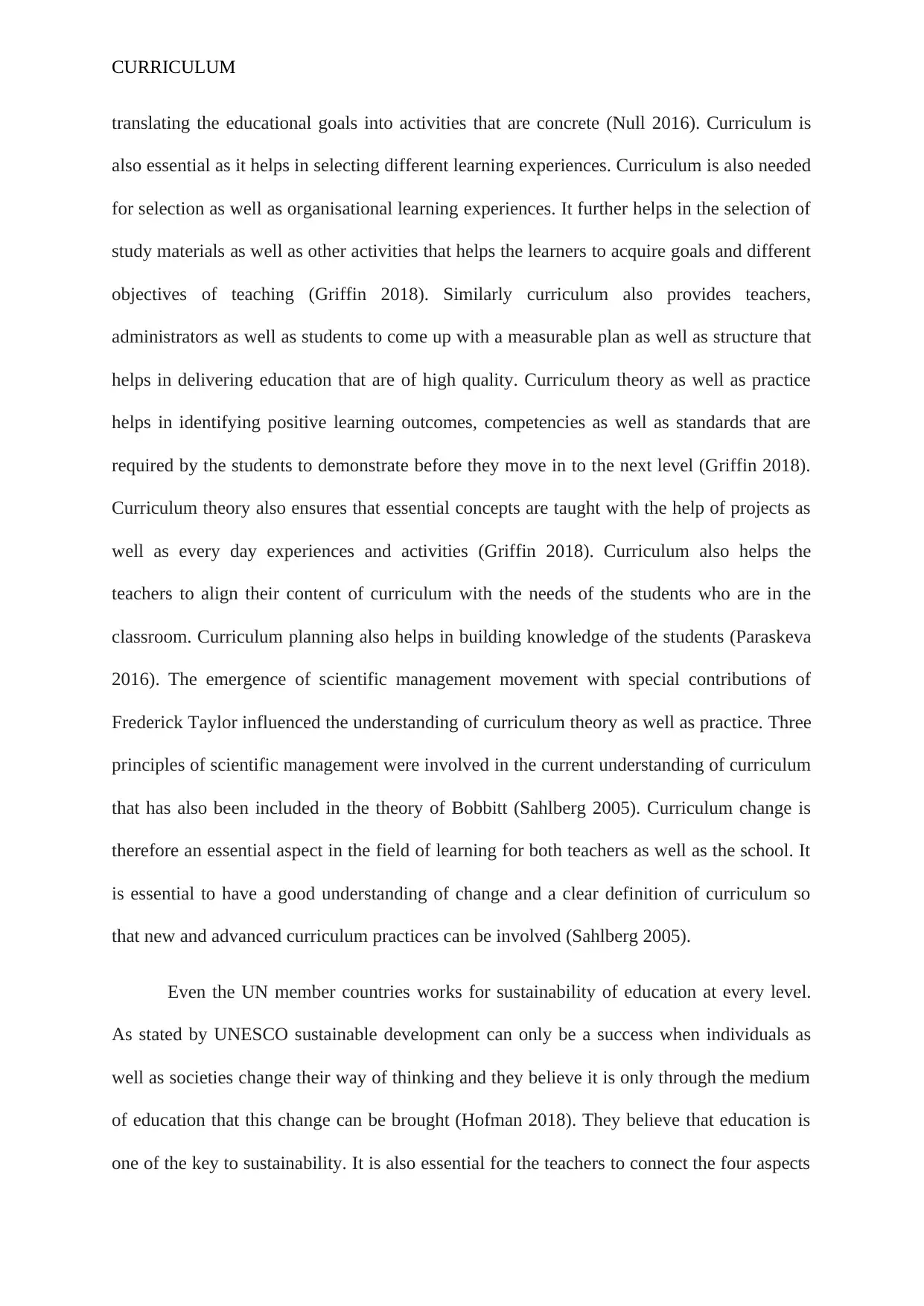
CURRICULUM
translating the educational goals into activities that are concrete (Null 2016). Curriculum is
also essential as it helps in selecting different learning experiences. Curriculum is also needed
for selection as well as organisational learning experiences. It further helps in the selection of
study materials as well as other activities that helps the learners to acquire goals and different
objectives of teaching (Griffin 2018). Similarly curriculum also provides teachers,
administrators as well as students to come up with a measurable plan as well as structure that
helps in delivering education that are of high quality. Curriculum theory as well as practice
helps in identifying positive learning outcomes, competencies as well as standards that are
required by the students to demonstrate before they move in to the next level (Griffin 2018).
Curriculum theory also ensures that essential concepts are taught with the help of projects as
well as every day experiences and activities (Griffin 2018). Curriculum also helps the
teachers to align their content of curriculum with the needs of the students who are in the
classroom. Curriculum planning also helps in building knowledge of the students (Paraskeva
2016). The emergence of scientific management movement with special contributions of
Frederick Taylor influenced the understanding of curriculum theory as well as practice. Three
principles of scientific management were involved in the current understanding of curriculum
that has also been included in the theory of Bobbitt (Sahlberg 2005). Curriculum change is
therefore an essential aspect in the field of learning for both teachers as well as the school. It
is essential to have a good understanding of change and a clear definition of curriculum so
that new and advanced curriculum practices can be involved (Sahlberg 2005).
Even the UN member countries works for sustainability of education at every level.
As stated by UNESCO sustainable development can only be a success when individuals as
well as societies change their way of thinking and they believe it is only through the medium
of education that this change can be brought (Hofman 2018). They believe that education is
one of the key to sustainability. It is also essential for the teachers to connect the four aspects
translating the educational goals into activities that are concrete (Null 2016). Curriculum is
also essential as it helps in selecting different learning experiences. Curriculum is also needed
for selection as well as organisational learning experiences. It further helps in the selection of
study materials as well as other activities that helps the learners to acquire goals and different
objectives of teaching (Griffin 2018). Similarly curriculum also provides teachers,
administrators as well as students to come up with a measurable plan as well as structure that
helps in delivering education that are of high quality. Curriculum theory as well as practice
helps in identifying positive learning outcomes, competencies as well as standards that are
required by the students to demonstrate before they move in to the next level (Griffin 2018).
Curriculum theory also ensures that essential concepts are taught with the help of projects as
well as every day experiences and activities (Griffin 2018). Curriculum also helps the
teachers to align their content of curriculum with the needs of the students who are in the
classroom. Curriculum planning also helps in building knowledge of the students (Paraskeva
2016). The emergence of scientific management movement with special contributions of
Frederick Taylor influenced the understanding of curriculum theory as well as practice. Three
principles of scientific management were involved in the current understanding of curriculum
that has also been included in the theory of Bobbitt (Sahlberg 2005). Curriculum change is
therefore an essential aspect in the field of learning for both teachers as well as the school. It
is essential to have a good understanding of change and a clear definition of curriculum so
that new and advanced curriculum practices can be involved (Sahlberg 2005).
Even the UN member countries works for sustainability of education at every level.
As stated by UNESCO sustainable development can only be a success when individuals as
well as societies change their way of thinking and they believe it is only through the medium
of education that this change can be brought (Hofman 2018). They believe that education is
one of the key to sustainability. It is also essential for the teachers to connect the four aspects
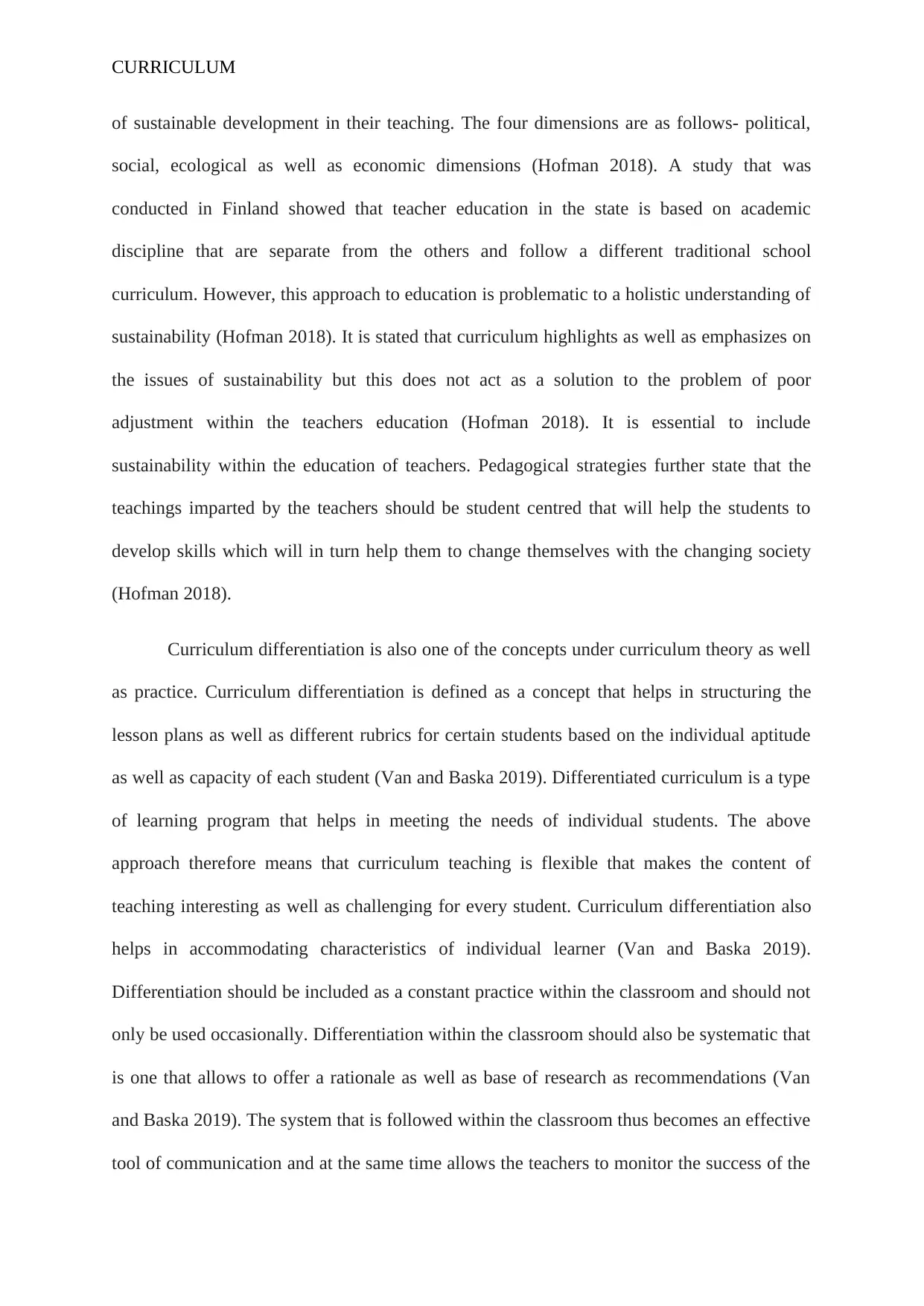
CURRICULUM
of sustainable development in their teaching. The four dimensions are as follows- political,
social, ecological as well as economic dimensions (Hofman 2018). A study that was
conducted in Finland showed that teacher education in the state is based on academic
discipline that are separate from the others and follow a different traditional school
curriculum. However, this approach to education is problematic to a holistic understanding of
sustainability (Hofman 2018). It is stated that curriculum highlights as well as emphasizes on
the issues of sustainability but this does not act as a solution to the problem of poor
adjustment within the teachers education (Hofman 2018). It is essential to include
sustainability within the education of teachers. Pedagogical strategies further state that the
teachings imparted by the teachers should be student centred that will help the students to
develop skills which will in turn help them to change themselves with the changing society
(Hofman 2018).
Curriculum differentiation is also one of the concepts under curriculum theory as well
as practice. Curriculum differentiation is defined as a concept that helps in structuring the
lesson plans as well as different rubrics for certain students based on the individual aptitude
as well as capacity of each student (Van and Baska 2019). Differentiated curriculum is a type
of learning program that helps in meeting the needs of individual students. The above
approach therefore means that curriculum teaching is flexible that makes the content of
teaching interesting as well as challenging for every student. Curriculum differentiation also
helps in accommodating characteristics of individual learner (Van and Baska 2019).
Differentiation should be included as a constant practice within the classroom and should not
only be used occasionally. Differentiation within the classroom should also be systematic that
is one that allows to offer a rationale as well as base of research as recommendations (Van
and Baska 2019). The system that is followed within the classroom thus becomes an effective
tool of communication and at the same time allows the teachers to monitor the success of the
of sustainable development in their teaching. The four dimensions are as follows- political,
social, ecological as well as economic dimensions (Hofman 2018). A study that was
conducted in Finland showed that teacher education in the state is based on academic
discipline that are separate from the others and follow a different traditional school
curriculum. However, this approach to education is problematic to a holistic understanding of
sustainability (Hofman 2018). It is stated that curriculum highlights as well as emphasizes on
the issues of sustainability but this does not act as a solution to the problem of poor
adjustment within the teachers education (Hofman 2018). It is essential to include
sustainability within the education of teachers. Pedagogical strategies further state that the
teachings imparted by the teachers should be student centred that will help the students to
develop skills which will in turn help them to change themselves with the changing society
(Hofman 2018).
Curriculum differentiation is also one of the concepts under curriculum theory as well
as practice. Curriculum differentiation is defined as a concept that helps in structuring the
lesson plans as well as different rubrics for certain students based on the individual aptitude
as well as capacity of each student (Van and Baska 2019). Differentiated curriculum is a type
of learning program that helps in meeting the needs of individual students. The above
approach therefore means that curriculum teaching is flexible that makes the content of
teaching interesting as well as challenging for every student. Curriculum differentiation also
helps in accommodating characteristics of individual learner (Van and Baska 2019).
Differentiation should be included as a constant practice within the classroom and should not
only be used occasionally. Differentiation within the classroom should also be systematic that
is one that allows to offer a rationale as well as base of research as recommendations (Van
and Baska 2019). The system that is followed within the classroom thus becomes an effective
tool of communication and at the same time allows the teachers to monitor the success of the
⊘ This is a preview!⊘
Do you want full access?
Subscribe today to unlock all pages.

Trusted by 1+ million students worldwide
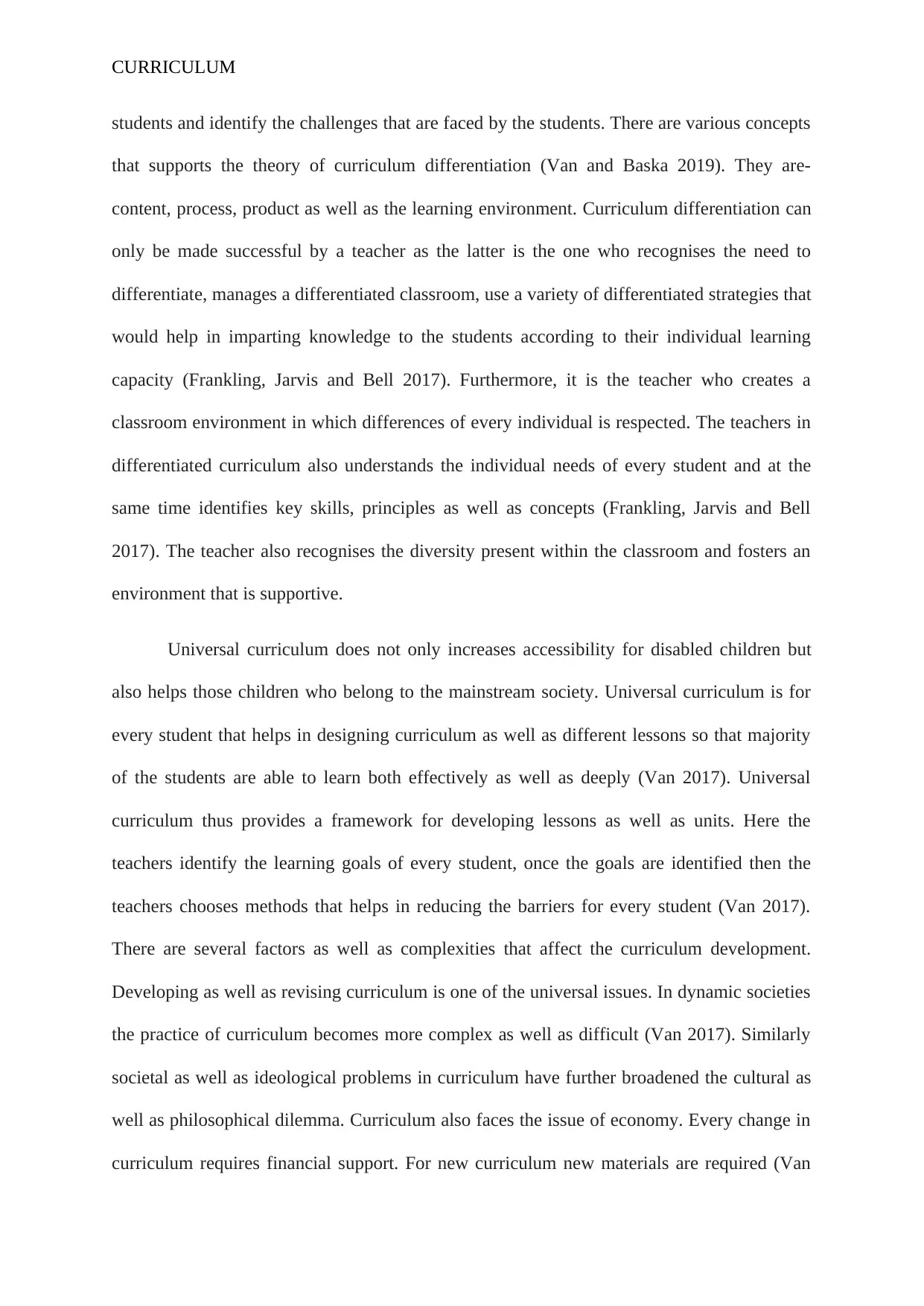
CURRICULUM
students and identify the challenges that are faced by the students. There are various concepts
that supports the theory of curriculum differentiation (Van and Baska 2019). They are-
content, process, product as well as the learning environment. Curriculum differentiation can
only be made successful by a teacher as the latter is the one who recognises the need to
differentiate, manages a differentiated classroom, use a variety of differentiated strategies that
would help in imparting knowledge to the students according to their individual learning
capacity (Frankling, Jarvis and Bell 2017). Furthermore, it is the teacher who creates a
classroom environment in which differences of every individual is respected. The teachers in
differentiated curriculum also understands the individual needs of every student and at the
same time identifies key skills, principles as well as concepts (Frankling, Jarvis and Bell
2017). The teacher also recognises the diversity present within the classroom and fosters an
environment that is supportive.
Universal curriculum does not only increases accessibility for disabled children but
also helps those children who belong to the mainstream society. Universal curriculum is for
every student that helps in designing curriculum as well as different lessons so that majority
of the students are able to learn both effectively as well as deeply (Van 2017). Universal
curriculum thus provides a framework for developing lessons as well as units. Here the
teachers identify the learning goals of every student, once the goals are identified then the
teachers chooses methods that helps in reducing the barriers for every student (Van 2017).
There are several factors as well as complexities that affect the curriculum development.
Developing as well as revising curriculum is one of the universal issues. In dynamic societies
the practice of curriculum becomes more complex as well as difficult (Van 2017). Similarly
societal as well as ideological problems in curriculum have further broadened the cultural as
well as philosophical dilemma. Curriculum also faces the issue of economy. Every change in
curriculum requires financial support. For new curriculum new materials are required (Van
students and identify the challenges that are faced by the students. There are various concepts
that supports the theory of curriculum differentiation (Van and Baska 2019). They are-
content, process, product as well as the learning environment. Curriculum differentiation can
only be made successful by a teacher as the latter is the one who recognises the need to
differentiate, manages a differentiated classroom, use a variety of differentiated strategies that
would help in imparting knowledge to the students according to their individual learning
capacity (Frankling, Jarvis and Bell 2017). Furthermore, it is the teacher who creates a
classroom environment in which differences of every individual is respected. The teachers in
differentiated curriculum also understands the individual needs of every student and at the
same time identifies key skills, principles as well as concepts (Frankling, Jarvis and Bell
2017). The teacher also recognises the diversity present within the classroom and fosters an
environment that is supportive.
Universal curriculum does not only increases accessibility for disabled children but
also helps those children who belong to the mainstream society. Universal curriculum is for
every student that helps in designing curriculum as well as different lessons so that majority
of the students are able to learn both effectively as well as deeply (Van 2017). Universal
curriculum thus provides a framework for developing lessons as well as units. Here the
teachers identify the learning goals of every student, once the goals are identified then the
teachers chooses methods that helps in reducing the barriers for every student (Van 2017).
There are several factors as well as complexities that affect the curriculum development.
Developing as well as revising curriculum is one of the universal issues. In dynamic societies
the practice of curriculum becomes more complex as well as difficult (Van 2017). Similarly
societal as well as ideological problems in curriculum have further broadened the cultural as
well as philosophical dilemma. Curriculum also faces the issue of economy. Every change in
curriculum requires financial support. For new curriculum new materials are required (Van
Paraphrase This Document
Need a fresh take? Get an instant paraphrase of this document with our AI Paraphraser
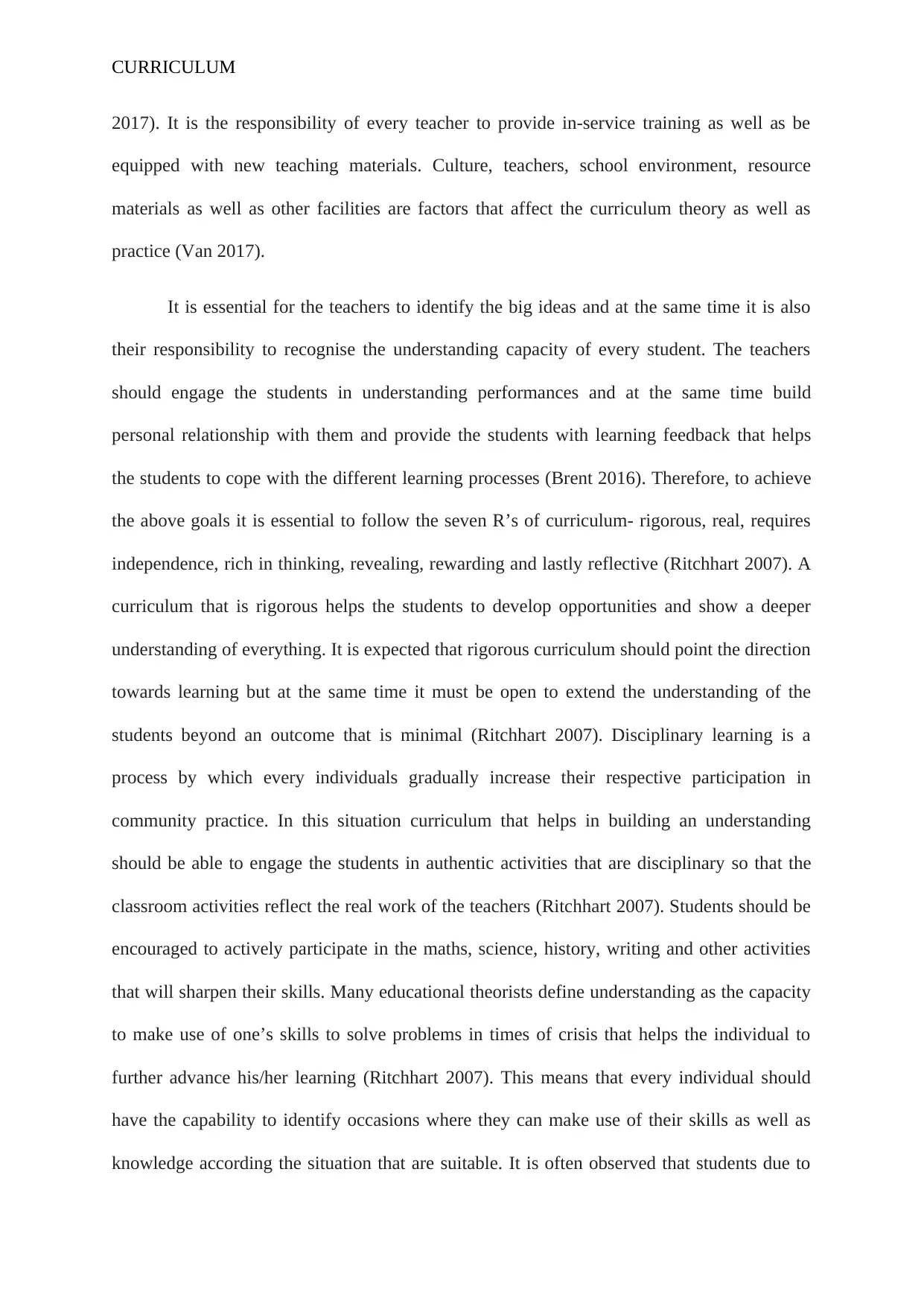
CURRICULUM
2017). It is the responsibility of every teacher to provide in-service training as well as be
equipped with new teaching materials. Culture, teachers, school environment, resource
materials as well as other facilities are factors that affect the curriculum theory as well as
practice (Van 2017).
It is essential for the teachers to identify the big ideas and at the same time it is also
their responsibility to recognise the understanding capacity of every student. The teachers
should engage the students in understanding performances and at the same time build
personal relationship with them and provide the students with learning feedback that helps
the students to cope with the different learning processes (Brent 2016). Therefore, to achieve
the above goals it is essential to follow the seven R’s of curriculum- rigorous, real, requires
independence, rich in thinking, revealing, rewarding and lastly reflective (Ritchhart 2007). A
curriculum that is rigorous helps the students to develop opportunities and show a deeper
understanding of everything. It is expected that rigorous curriculum should point the direction
towards learning but at the same time it must be open to extend the understanding of the
students beyond an outcome that is minimal (Ritchhart 2007). Disciplinary learning is a
process by which every individuals gradually increase their respective participation in
community practice. In this situation curriculum that helps in building an understanding
should be able to engage the students in authentic activities that are disciplinary so that the
classroom activities reflect the real work of the teachers (Ritchhart 2007). Students should be
encouraged to actively participate in the maths, science, history, writing and other activities
that will sharpen their skills. Many educational theorists define understanding as the capacity
to make use of one’s skills to solve problems in times of crisis that helps the individual to
further advance his/her learning (Ritchhart 2007). This means that every individual should
have the capability to identify occasions where they can make use of their skills as well as
knowledge according the situation that are suitable. It is often observed that students due to
2017). It is the responsibility of every teacher to provide in-service training as well as be
equipped with new teaching materials. Culture, teachers, school environment, resource
materials as well as other facilities are factors that affect the curriculum theory as well as
practice (Van 2017).
It is essential for the teachers to identify the big ideas and at the same time it is also
their responsibility to recognise the understanding capacity of every student. The teachers
should engage the students in understanding performances and at the same time build
personal relationship with them and provide the students with learning feedback that helps
the students to cope with the different learning processes (Brent 2016). Therefore, to achieve
the above goals it is essential to follow the seven R’s of curriculum- rigorous, real, requires
independence, rich in thinking, revealing, rewarding and lastly reflective (Ritchhart 2007). A
curriculum that is rigorous helps the students to develop opportunities and show a deeper
understanding of everything. It is expected that rigorous curriculum should point the direction
towards learning but at the same time it must be open to extend the understanding of the
students beyond an outcome that is minimal (Ritchhart 2007). Disciplinary learning is a
process by which every individuals gradually increase their respective participation in
community practice. In this situation curriculum that helps in building an understanding
should be able to engage the students in authentic activities that are disciplinary so that the
classroom activities reflect the real work of the teachers (Ritchhart 2007). Students should be
encouraged to actively participate in the maths, science, history, writing and other activities
that will sharpen their skills. Many educational theorists define understanding as the capacity
to make use of one’s skills to solve problems in times of crisis that helps the individual to
further advance his/her learning (Ritchhart 2007). This means that every individual should
have the capability to identify occasions where they can make use of their skills as well as
knowledge according the situation that are suitable. It is often observed that students due to
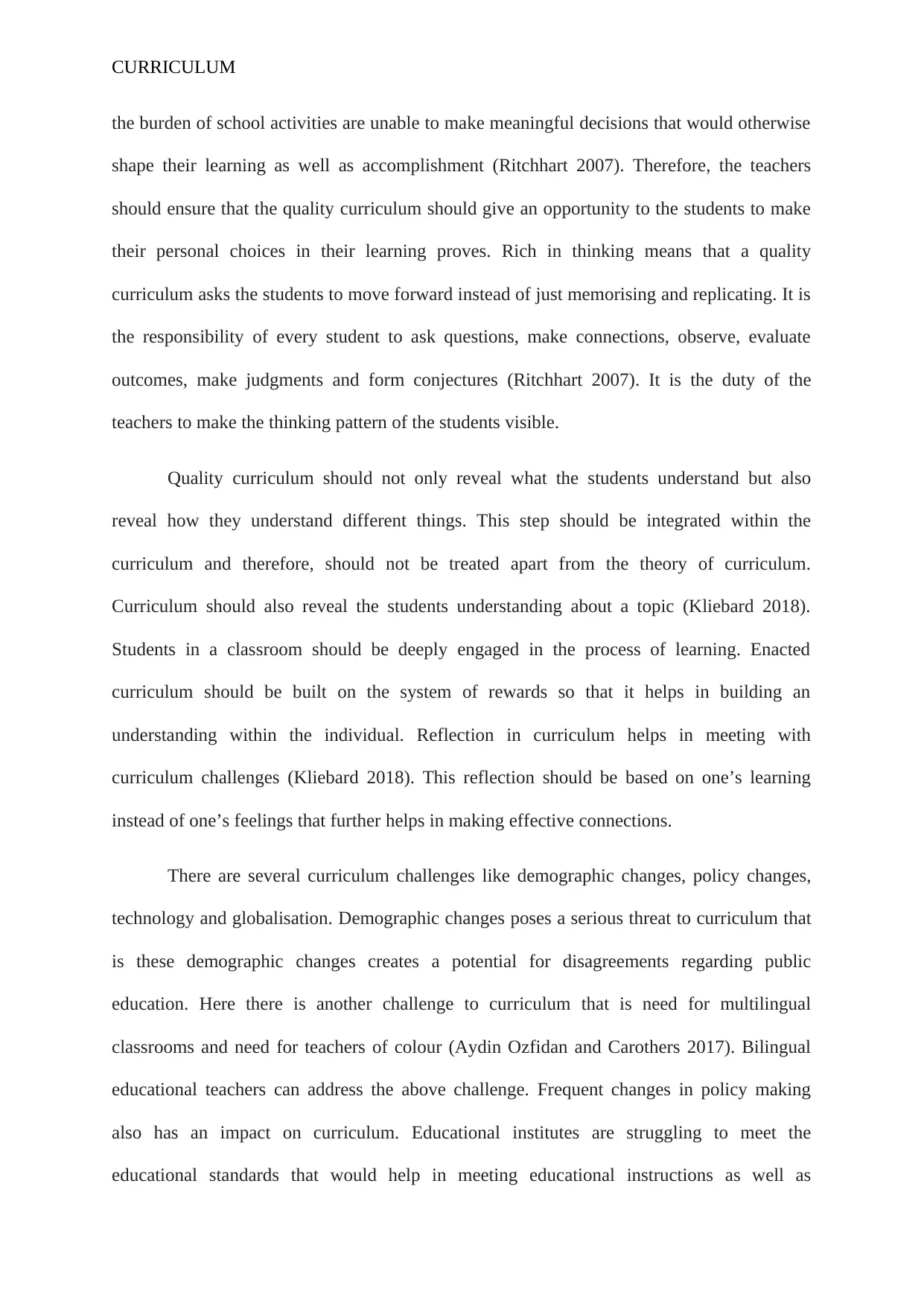
CURRICULUM
the burden of school activities are unable to make meaningful decisions that would otherwise
shape their learning as well as accomplishment (Ritchhart 2007). Therefore, the teachers
should ensure that the quality curriculum should give an opportunity to the students to make
their personal choices in their learning proves. Rich in thinking means that a quality
curriculum asks the students to move forward instead of just memorising and replicating. It is
the responsibility of every student to ask questions, make connections, observe, evaluate
outcomes, make judgments and form conjectures (Ritchhart 2007). It is the duty of the
teachers to make the thinking pattern of the students visible.
Quality curriculum should not only reveal what the students understand but also
reveal how they understand different things. This step should be integrated within the
curriculum and therefore, should not be treated apart from the theory of curriculum.
Curriculum should also reveal the students understanding about a topic (Kliebard 2018).
Students in a classroom should be deeply engaged in the process of learning. Enacted
curriculum should be built on the system of rewards so that it helps in building an
understanding within the individual. Reflection in curriculum helps in meeting with
curriculum challenges (Kliebard 2018). This reflection should be based on one’s learning
instead of one’s feelings that further helps in making effective connections.
There are several curriculum challenges like demographic changes, policy changes,
technology and globalisation. Demographic changes poses a serious threat to curriculum that
is these demographic changes creates a potential for disagreements regarding public
education. Here there is another challenge to curriculum that is need for multilingual
classrooms and need for teachers of colour (Aydin Ozfidan and Carothers 2017). Bilingual
educational teachers can address the above challenge. Frequent changes in policy making
also has an impact on curriculum. Educational institutes are struggling to meet the
educational standards that would help in meeting educational instructions as well as
the burden of school activities are unable to make meaningful decisions that would otherwise
shape their learning as well as accomplishment (Ritchhart 2007). Therefore, the teachers
should ensure that the quality curriculum should give an opportunity to the students to make
their personal choices in their learning proves. Rich in thinking means that a quality
curriculum asks the students to move forward instead of just memorising and replicating. It is
the responsibility of every student to ask questions, make connections, observe, evaluate
outcomes, make judgments and form conjectures (Ritchhart 2007). It is the duty of the
teachers to make the thinking pattern of the students visible.
Quality curriculum should not only reveal what the students understand but also
reveal how they understand different things. This step should be integrated within the
curriculum and therefore, should not be treated apart from the theory of curriculum.
Curriculum should also reveal the students understanding about a topic (Kliebard 2018).
Students in a classroom should be deeply engaged in the process of learning. Enacted
curriculum should be built on the system of rewards so that it helps in building an
understanding within the individual. Reflection in curriculum helps in meeting with
curriculum challenges (Kliebard 2018). This reflection should be based on one’s learning
instead of one’s feelings that further helps in making effective connections.
There are several curriculum challenges like demographic changes, policy changes,
technology and globalisation. Demographic changes poses a serious threat to curriculum that
is these demographic changes creates a potential for disagreements regarding public
education. Here there is another challenge to curriculum that is need for multilingual
classrooms and need for teachers of colour (Aydin Ozfidan and Carothers 2017). Bilingual
educational teachers can address the above challenge. Frequent changes in policy making
also has an impact on curriculum. Educational institutes are struggling to meet the
educational standards that would help in meeting educational instructions as well as
⊘ This is a preview!⊘
Do you want full access?
Subscribe today to unlock all pages.

Trusted by 1+ million students worldwide
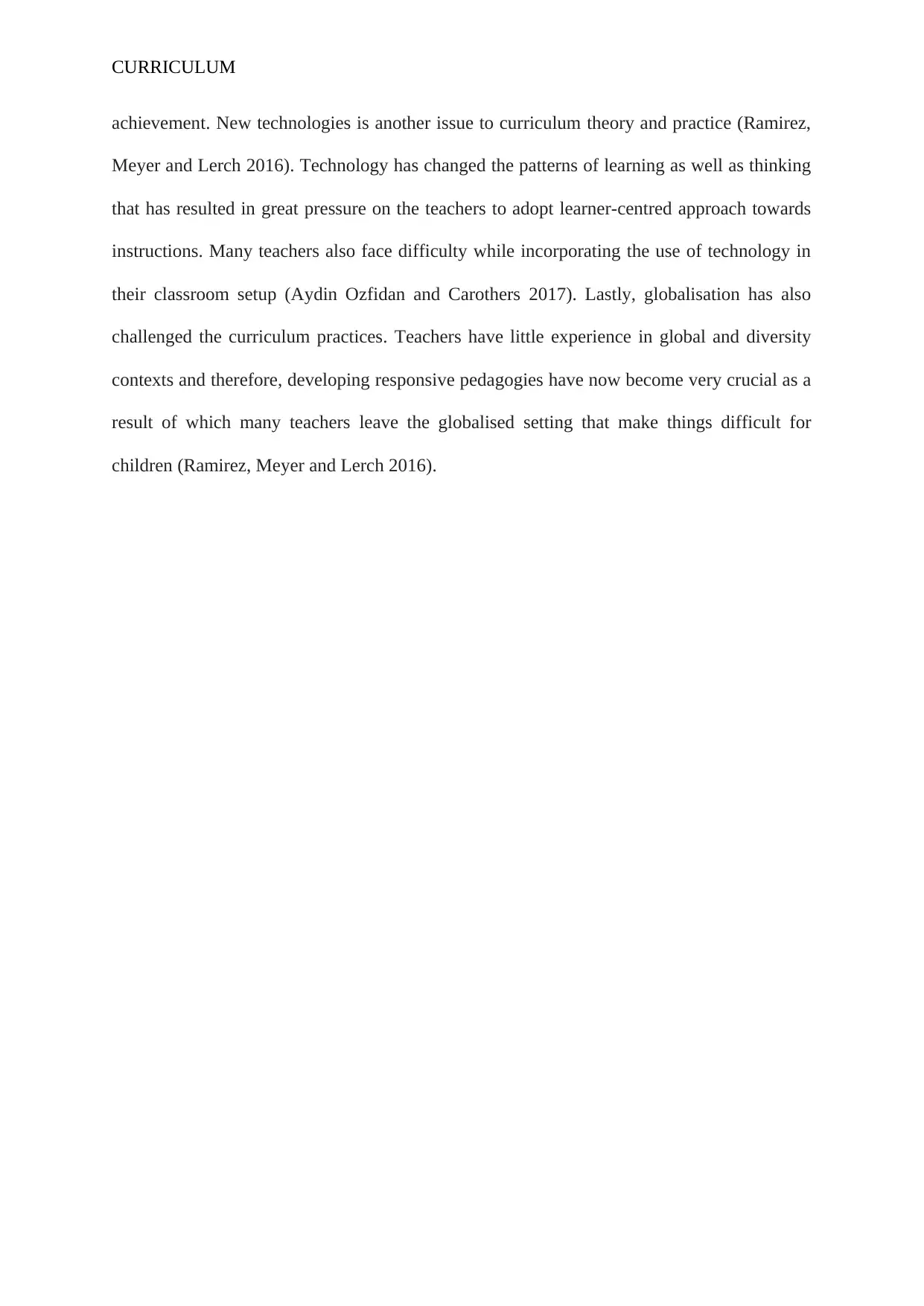
CURRICULUM
achievement. New technologies is another issue to curriculum theory and practice (Ramirez,
Meyer and Lerch 2016). Technology has changed the patterns of learning as well as thinking
that has resulted in great pressure on the teachers to adopt learner-centred approach towards
instructions. Many teachers also face difficulty while incorporating the use of technology in
their classroom setup (Aydin Ozfidan and Carothers 2017). Lastly, globalisation has also
challenged the curriculum practices. Teachers have little experience in global and diversity
contexts and therefore, developing responsive pedagogies have now become very crucial as a
result of which many teachers leave the globalised setting that make things difficult for
children (Ramirez, Meyer and Lerch 2016).
achievement. New technologies is another issue to curriculum theory and practice (Ramirez,
Meyer and Lerch 2016). Technology has changed the patterns of learning as well as thinking
that has resulted in great pressure on the teachers to adopt learner-centred approach towards
instructions. Many teachers also face difficulty while incorporating the use of technology in
their classroom setup (Aydin Ozfidan and Carothers 2017). Lastly, globalisation has also
challenged the curriculum practices. Teachers have little experience in global and diversity
contexts and therefore, developing responsive pedagogies have now become very crucial as a
result of which many teachers leave the globalised setting that make things difficult for
children (Ramirez, Meyer and Lerch 2016).
Paraphrase This Document
Need a fresh take? Get an instant paraphrase of this document with our AI Paraphraser
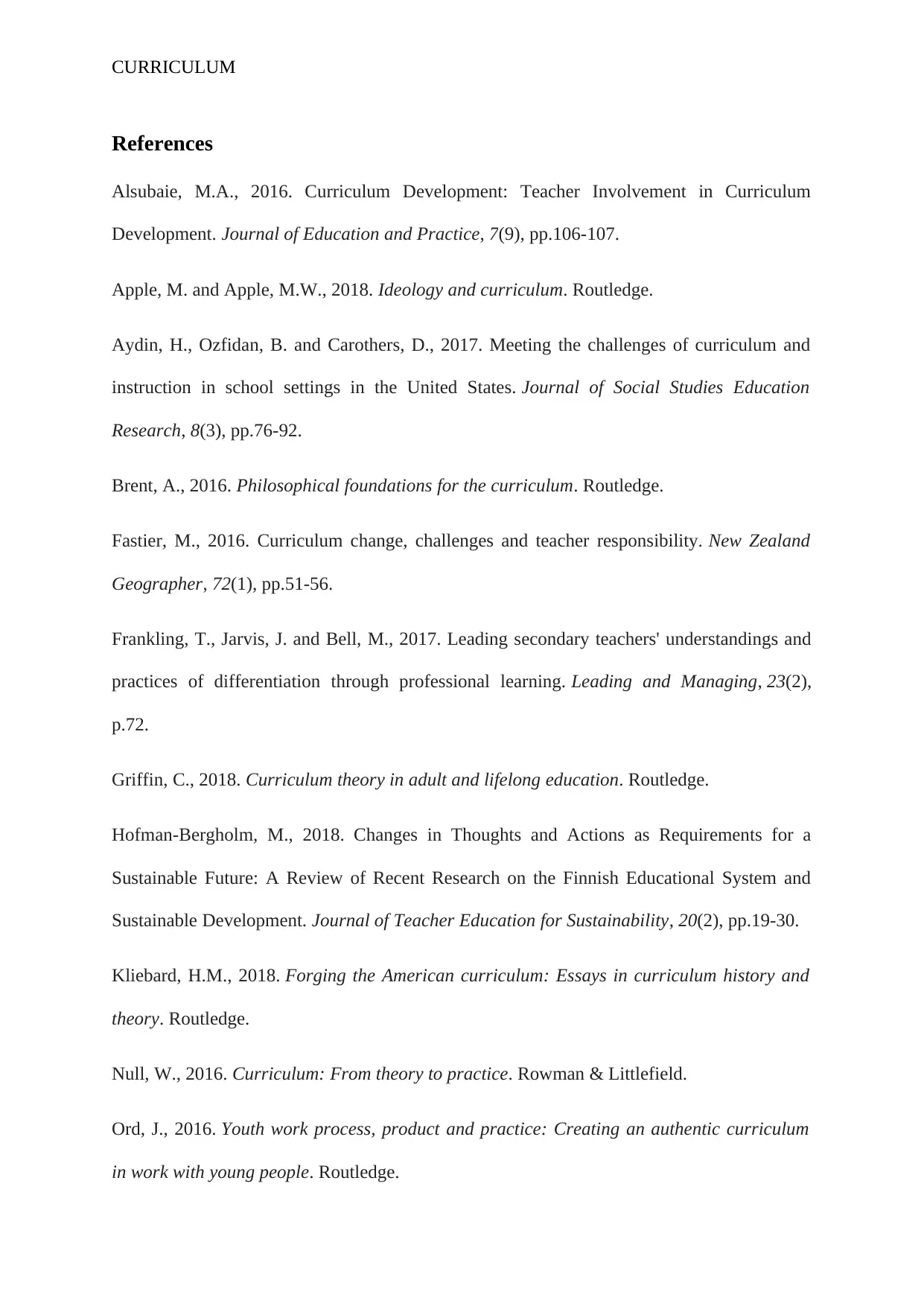
CURRICULUM
References
Alsubaie, M.A., 2016. Curriculum Development: Teacher Involvement in Curriculum
Development. Journal of Education and Practice, 7(9), pp.106-107.
Apple, M. and Apple, M.W., 2018. Ideology and curriculum. Routledge.
Aydin, H., Ozfidan, B. and Carothers, D., 2017. Meeting the challenges of curriculum and
instruction in school settings in the United States. Journal of Social Studies Education
Research, 8(3), pp.76-92.
Brent, A., 2016. Philosophical foundations for the curriculum. Routledge.
Fastier, M., 2016. Curriculum change, challenges and teacher responsibility. New Zealand
Geographer, 72(1), pp.51-56.
Frankling, T., Jarvis, J. and Bell, M., 2017. Leading secondary teachers' understandings and
practices of differentiation through professional learning. Leading and Managing, 23(2),
p.72.
Griffin, C., 2018. Curriculum theory in adult and lifelong education. Routledge.
Hofman-Bergholm, M., 2018. Changes in Thoughts and Actions as Requirements for a
Sustainable Future: A Review of Recent Research on the Finnish Educational System and
Sustainable Development. Journal of Teacher Education for Sustainability, 20(2), pp.19-30.
Kliebard, H.M., 2018. Forging the American curriculum: Essays in curriculum history and
theory. Routledge.
Null, W., 2016. Curriculum: From theory to practice. Rowman & Littlefield.
Ord, J., 2016. Youth work process, product and practice: Creating an authentic curriculum
in work with young people. Routledge.
References
Alsubaie, M.A., 2016. Curriculum Development: Teacher Involvement in Curriculum
Development. Journal of Education and Practice, 7(9), pp.106-107.
Apple, M. and Apple, M.W., 2018. Ideology and curriculum. Routledge.
Aydin, H., Ozfidan, B. and Carothers, D., 2017. Meeting the challenges of curriculum and
instruction in school settings in the United States. Journal of Social Studies Education
Research, 8(3), pp.76-92.
Brent, A., 2016. Philosophical foundations for the curriculum. Routledge.
Fastier, M., 2016. Curriculum change, challenges and teacher responsibility. New Zealand
Geographer, 72(1), pp.51-56.
Frankling, T., Jarvis, J. and Bell, M., 2017. Leading secondary teachers' understandings and
practices of differentiation through professional learning. Leading and Managing, 23(2),
p.72.
Griffin, C., 2018. Curriculum theory in adult and lifelong education. Routledge.
Hofman-Bergholm, M., 2018. Changes in Thoughts and Actions as Requirements for a
Sustainable Future: A Review of Recent Research on the Finnish Educational System and
Sustainable Development. Journal of Teacher Education for Sustainability, 20(2), pp.19-30.
Kliebard, H.M., 2018. Forging the American curriculum: Essays in curriculum history and
theory. Routledge.
Null, W., 2016. Curriculum: From theory to practice. Rowman & Littlefield.
Ord, J., 2016. Youth work process, product and practice: Creating an authentic curriculum
in work with young people. Routledge.
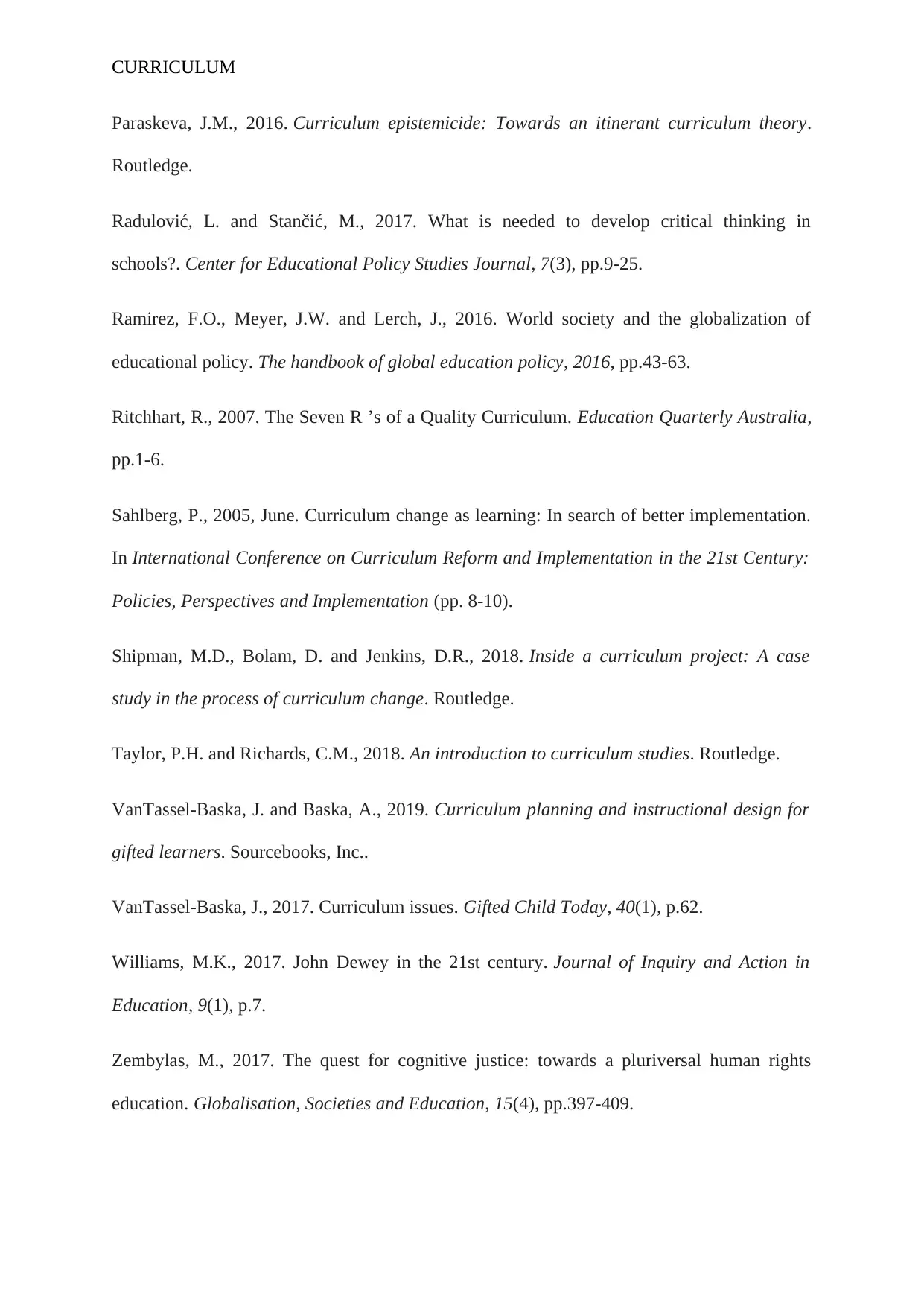
CURRICULUM
Paraskeva, J.M., 2016. Curriculum epistemicide: Towards an itinerant curriculum theory.
Routledge.
Radulović, L. and Stančić, M., 2017. What is needed to develop critical thinking in
schools?. Center for Educational Policy Studies Journal, 7(3), pp.9-25.
Ramirez, F.O., Meyer, J.W. and Lerch, J., 2016. World society and the globalization of
educational policy. The handbook of global education policy, 2016, pp.43-63.
Ritchhart, R., 2007. The Seven R ʼs of a Quality Curriculum. Education Quarterly Australia,
pp.1-6.
Sahlberg, P., 2005, June. Curriculum change as learning: In search of better implementation.
In International Conference on Curriculum Reform and Implementation in the 21st Century:
Policies, Perspectives and Implementation (pp. 8-10).
Shipman, M.D., Bolam, D. and Jenkins, D.R., 2018. Inside a curriculum project: A case
study in the process of curriculum change. Routledge.
Taylor, P.H. and Richards, C.M., 2018. An introduction to curriculum studies. Routledge.
VanTassel-Baska, J. and Baska, A., 2019. Curriculum planning and instructional design for
gifted learners. Sourcebooks, Inc..
VanTassel-Baska, J., 2017. Curriculum issues. Gifted Child Today, 40(1), p.62.
Williams, M.K., 2017. John Dewey in the 21st century. Journal of Inquiry and Action in
Education, 9(1), p.7.
Zembylas, M., 2017. The quest for cognitive justice: towards a pluriversal human rights
education. Globalisation, Societies and Education, 15(4), pp.397-409.
Paraskeva, J.M., 2016. Curriculum epistemicide: Towards an itinerant curriculum theory.
Routledge.
Radulović, L. and Stančić, M., 2017. What is needed to develop critical thinking in
schools?. Center for Educational Policy Studies Journal, 7(3), pp.9-25.
Ramirez, F.O., Meyer, J.W. and Lerch, J., 2016. World society and the globalization of
educational policy. The handbook of global education policy, 2016, pp.43-63.
Ritchhart, R., 2007. The Seven R ʼs of a Quality Curriculum. Education Quarterly Australia,
pp.1-6.
Sahlberg, P., 2005, June. Curriculum change as learning: In search of better implementation.
In International Conference on Curriculum Reform and Implementation in the 21st Century:
Policies, Perspectives and Implementation (pp. 8-10).
Shipman, M.D., Bolam, D. and Jenkins, D.R., 2018. Inside a curriculum project: A case
study in the process of curriculum change. Routledge.
Taylor, P.H. and Richards, C.M., 2018. An introduction to curriculum studies. Routledge.
VanTassel-Baska, J. and Baska, A., 2019. Curriculum planning and instructional design for
gifted learners. Sourcebooks, Inc..
VanTassel-Baska, J., 2017. Curriculum issues. Gifted Child Today, 40(1), p.62.
Williams, M.K., 2017. John Dewey in the 21st century. Journal of Inquiry and Action in
Education, 9(1), p.7.
Zembylas, M., 2017. The quest for cognitive justice: towards a pluriversal human rights
education. Globalisation, Societies and Education, 15(4), pp.397-409.
⊘ This is a preview!⊘
Do you want full access?
Subscribe today to unlock all pages.

Trusted by 1+ million students worldwide
1 out of 12
Related Documents
Your All-in-One AI-Powered Toolkit for Academic Success.
+13062052269
info@desklib.com
Available 24*7 on WhatsApp / Email
![[object Object]](/_next/static/media/star-bottom.7253800d.svg)
Unlock your academic potential
Copyright © 2020–2025 A2Z Services. All Rights Reserved. Developed and managed by ZUCOL.





